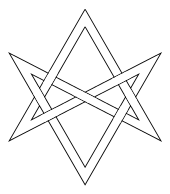Unicursal hexagram


The unicursal hexagram is a hexagram or six-pointed star that can be traced or drawn unicursally, in one continuous line rather than by two overlaid triangles. The hexagram can also be depicted inside a circle with the points touching it. It is often depicted in an interlaced form with the lines of the hexagram passing over and under one another to form a knot. It is the same shape as depicted in Blaise Pascal's 1639 Hexagrammum Mysticum Theorem.[citation needed]
Thelema

In Aleister Crowley's Thelema, the hexagram is usually depicted with a five-petalled flower in the centre which symbolises a pentacle. The symbol itself is the equivalent of the ancient Egyptian Ankh, or the Rosicrucian's Rosy Cross; which represents the microcosmic forces (the pentacle, representation of the pentagram with 5 elements, the Pentagrammaton, YHSVH or Yahshuah) interweave with the macro-cosmic forces (the hexagram, the representation of the planetary or heavenly cosmic forces, the divine).[2]
In popular culture
- The unicursal hexagram was part of the symbol called "The Seal of Orichalcos" that was prominent in the Waking the Dragons arc of Yu-Gi-Oh! (1996-2004).[citation needed][3]
- The unicursal hexagram is used in the Anime "Rental Magica" to summon an Angel capable of erasing the memories of the Num that was used as an Index of prohibited books, to keep her under the concontrol of the church.
- A unicursal hexagram appears several times in the television series Supernatural as a symbol to ward off evil entities. It was also featured prominently in the season 8 episode "As Time Goes By" as the symbol signifying membership of the Men of Letters. It's mentioned that it stands above the gates to Atlantis.[citation needed]
- A modified version of the symbol appears on the cover of Mindless Self Indulgence's fifth studio album How I Learned to Stop Giving a Shit and Love Mindless Self Indulgence.
- Serves as a symbol of Inferno fraction in the Heroes of Might and Magic V.
- Appears on the American flag on the cover of the single Drown by Bring Me The Horizon
- The unicursal hexagram has been used by the band Behemoth (band) as a part of the stage props for their lives performances.
See also
References
- ^ Walker, Barbara G. (1988). The Woman's Dictionary of Symbols and Sacred Objects. HarperOne. p. 69. ISBN 0-06-250923-3.
- ^ Duquette, Lon Milo (2003). Understanding Aleister Crowley's Thoth Tarot. Weiser. pp. 43–53. ISBN 1578632765.
- ^ Takahashi, Kasuki. "The Seal of Orichalcos" Yu-Gi-Oh card database.
